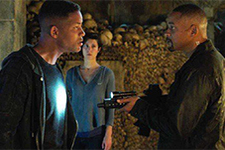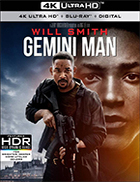Gemini Man (4K UHD)
|  In Ang Lee’s Gemini Man, Will Smith, with the assistance from a small army of digital technicians and animators, plays two characters: a 50-year-old master assassin on the verge of retirement named Henry Brogan and a 24-year-old man known only as a Junior who has been secretly cloned from Henry’s DNA. In the film’s opening sequence, Henry has been dispatched by his handler, Jack Willis (Douglas Hodge), to take out a man on a speeding bullet train in Belgium. He has been told that this man is a dangerous bioterrorist, and he does as instructed. However, he later learns that he has been duped into killing an innocent biologist at the behest of Clay Veris (Clive Owen), the shady government operative who trained him to be the world’s best killer. Because Henry “knows too much,” he must be taken out, and after others fail to get the job done, Clay dispatches Junior to kill him. Thus, Henry’s clone—his younger self, in effect—is sent to take him out, and neither one knows who the other is until they find themselves face to strangely familiar face. For most of its run-time, Gemini Man is essentially a long international chase film, with Henry trying to escape the death order that has been placed on his head. He is aided and abetted by Danny Zakarweski (Mary Elizabeth Winstead), a young agent who was tasked with monitoring Henry until she learns of his predicament and becomes a target herself, and Baron (Benedict Wong), an old friend who is the kind of guy who can fly planes, knows people, and has hiding places all over the world. Junior’s relentlessness in tracking Henry reflects Henry’s own dogged professionalism, which has taken him to the end of his line (the opening assassination was supposed to be his last—the final hit that always turns out not to be the final hit). The screenplay by David Benioff (Game of Thrones), Billy Ray (The Last Tycoon), and Darren Lemke (Goosebumps) has a few third-act tricks up its sleeve, partially regarding the life-and-death relationship between Henry and Junior, but for the most part it is a tried-and-true genre rundown, taking us through a series of exotic and extremely photogenic locales while Henry tries to stay alive and figure out who is tracking him and why. Along the way Ang Lee and cinematographer Dion Bebee (a regular collaborator with Michael Mann and Rob Marshall) stage some genuinely thrilling actions set-pieces, the best being a high-speed motorcycle duel through the narrow streets and along an imposing seawall in Cartagena and later a bout of intense fisticuffs in the skull-encrusted catacombs beneath an towering castle in Budapest. The climax occurs in a small town, with the quaint main street turned into a war zone as Clay brings out his own army of masked killers, one of whom wields a high-powered machine gun that literally shreds anything in its path. Because Lee is decidedly more interested in human drama than he is explosions and gunfire (although he is very good at choreographing the latter), every battle and every fight in Gemini Man carries with it an existential heft, as we are made acutely aware that Henry is literally himself. The conflict is literally both internal and external, and Lee spends just as much time with the characters in deep conversation as he does with them battling it out. Just as he did with his much maligned comic book adaptation Hulk (2003), which was an interesting failed experiment, Lee is attempting to add dramatic and thematic gravitas to a genre known primarily for its surface thrills. He wants to push the envelope, not just in terms of pyrotechnics, but also in terms of the human dimension. To that end, his work with Will Smith is duly impressive, even if half the time we’re watching a computer-generated approximation of the multi-Oscar-nominated actor. Which brings us to Gemini Man’s most challenging dimension: its heavy reliance on digital effects and Lee’s decision to shoot the film in 4K video at the extremely high frame rate of 120 fps (standard film speed has been 24 fps since the early 1930s). The digital effects are mostly excellent, with the digital Will Smith playing a quite convincing role opposite the real deal. There are times when the seams show, as creating a completely digital human being with dramatic weight inseparable from flesh and blood is arguably an unattainable goal, but the digital artists working behind the scenes have come almost frightening close, and I’d be lying if I said I wasn’t convinced most of the time. More problematic, though, is the film’s high-frame-rate cinematography. Lee previously experimented with this technology in his war drama Billy Lynn’s Long Halftime Walk (2016), as have other filmmakers (most notably Peter Jackson in his Hobbit trilogy), but he seems to have a fundamental misunderstanding of its effectiveness. The high frame rate produces ultra-sharp, highly detailed images that lack motion blur; thus, they do not look like traditional cinema, but rather like a video game. The effect is one of hyper-reality that is unnaturally crisp and sharp and almost mechanical in its feel; the irony is that the ability to capture fine detail transcends our normal perception and renders the image fundamentally artificial, which is completely at odds with Lee’s desire to make an action film that is physically robust and dramatically powerful.
Copyright © 2020 James Kendrick Thoughts? E-mail James Kendrick All images copyright © Paramount Home Entertainment | |||||||||||||||||||||||||||||
Overall Rating: 

 (2.5)
(2.5)


